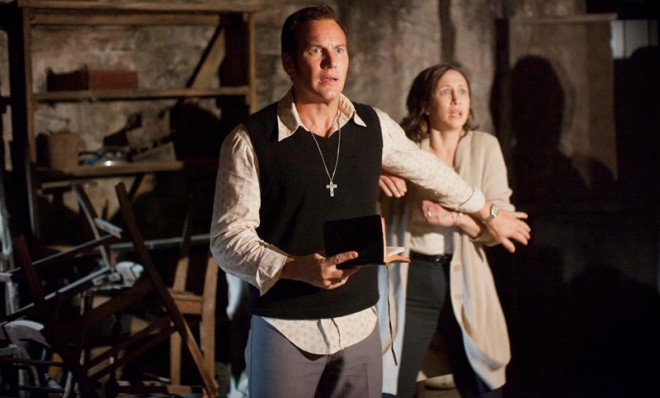The real story behind The Conjuring and four other horror movies 'based on a true story'
Don't believe everything you see


Last weekend, James Wan's paranormal thriller The Conjuring scared both moviegoers and its box-office competition with a hefty $41 million gross in the middle of summer — a time when we're all supposed to be watching movies about superheroes and giant robots. Made on a relatively thrifty budget of $20 million, The Conjuring outgrossed its far more expensive rivals like R.I.P.D. and Turbo on a marketing campaign that can be boiled down to five words: "Based on a true story."
It's a familiar promise to horror fans, who have been inundated with ghost stories making similar claims to veracity. But how much truth can there really be in stories about poltergeists and demonic possessions? Here, we fact-check The Conjuring and four other "based on a true story" horror movies:
1. The Conjuring
The Week
Escape your echo chamber. Get the facts behind the news, plus analysis from multiple perspectives.

Sign up for The Week's Free Newsletters
From our morning news briefing to a weekly Good News Newsletter, get the best of The Week delivered directly to your inbox.
From our morning news briefing to a weekly Good News Newsletter, get the best of The Week delivered directly to your inbox.
The movie:
A family is beset by a series of wrathful wraiths after they move into a colonial farmhouse. When the ghosts begin to target their young daughters, they hire a pair of paranormal investigators to end the haunting once and for all.
The true story:
The Conjuring's poster boldly proclaims that it's "based on the true case files of the Warrens." So who are the Warrens, anyway? The real-life couple, Ed and Lorraine (played in the film by Vera Farmiga and Patrick Wilson), were American paranormal investigators that founded the New England Society for Psychic Research in 1952.
A free daily email with the biggest news stories of the day – and the best features from TheWeek.com
The Warrens' 10,000-plus career cases include the alleged haunting depicted in The Conjuring. In 1971, Roger and Carolyn Perron moved into a colonial farmhouse in Harrisville, R.I., with their five daughters, and quickly began experiencing what they described as both haunting and spiritual possessions. They invited the Warrens to the farmhouse to investigate. Over the nine years they lived in the house, the Perrons described spirits, both harmless and angry, that "stunk of rotting flesh" and routinely arrived at 5:15 a.m. to levitate their beds.
So how much of that is true? The real-life Perron family swears by their story, throwing their full weight behind the film and even appearing in some of The Conjuring's marketing materials. "Because I was the youngest and the most vulnerable, I was approached more than anyone, and I actually had a relationship with that [ghostly] boy," said April Perron in a trailer promoting the film.
Of course, there are plenty of people who doubt the story. Steven Novella, the president of the New England Skeptical Society, told USA Today that "there is absolutely no reason to believe there is any legitimacy" to the Warrens' reports on the Perron haunting — or, for that matter, to any of the Warrens' cases.
The Conjuring "is a fair reflection of the chaos and danger we faced at the farm," countered Andrea Perron. "There are liberties taken and a few discrepancies, but overall, it is what it claims to be — based on a true story, believe it or not." Watch Perron describe her experiences in more details here:
2. The Devil Inside
The movie:
A young woman hires a film crew to follow her to Italy, where she intends to investigate a triple homicide committed by her mother during an exorcism gone wrong.
The true story:
The 2012 surprise megahit turned its paltry $1 million budget into a $100 million gross on the back of a marketing campaign that claimed the movie was "based on true events." What does that mean, exactly? Star Fernanda Andrade claimed that The Devil Inside was "inspired by several real accounts of possession," but doesn't specify which ones. A search for crimes committed by someone named Maria Rossi turned up a disturbing 1993 murder case — but that was a case without claims of satanic possession, and bearing no resemblance to the film's plot. Short answer: It's probably safe to file The Devil Inside under "very, very, very loosely based on true events."
3. The Haunting in Connecticut
The movie:
When a family moves closer to a hospital to receive better care for their cancer-ridden teenage son, they discover that their new home used to be a funeral home — and that the spirits of the dead aren't exactly happy they moved in.
The true story:
The Haunting in Connecticut — which, like The Devil Inside, was promoted as being "based on true events" — was purportedly based on the alleged haunting of the Snedeker family in Southington, Conn., in the 1980s. After renting a new home, Carmen Snedeker discovered that the house had once been a mortuary, and that the tools used on the corpses were still in the basement. The Snedekers were beset by "strange and disturbing phenomena," which they believed to be demons. They eventually contacted our old friends Ed and Lorraine Warren to investigate, and discovered that an employee of the mortuary had been convicted of necrophilia. Before The Haunting in Connecticut, their story formed the basis for a TV documentary and a book titled In a Dark Place: The Story of a True Haunting.
Pretty creepy, right? Just one problem: The book's author, Ray Garton, has since revealed that he didn't believe the story himself. In fact, he wanted In a Dark Place to be published as fiction, but was overruled by his editor. "Elements of Carmen Snedeker's story clashed with elements of Al Snedeker's story, and it seemed everyone was having a problem keeping their stories straight," said Garton in an interview with Yahoo! News. Garton also alleges that he approached the Warrens with his concerns, and that they urged him to just "make it up and make it scary."
In short: Yes, The Haunting in Connecticut is based on a "true story" — it's just a "true story" that has since been disowned by its author.
4. The Amityville Horror
The movie:
A family experiences a series of strange, paranormal events after moving into a house in which a murder was committed less than a year earlier.
The true story:
The Amityville Horror is based on Jay Anson's book of the same name — a best-seller that boldly proclaims itself to be a true story on its cover. The book tells the story of the Lutz family, who moved into 112 Ocean Ave. in Long Island, N.Y., 13 months after 23-year-old Ronald DeFeo Jr. murdered his parents and siblings there. The Lutzes stayed for just 28 days, citing a wide range of frightening paranormal activity, including swarms of flies, vivid nightmares, and the appearance of cloven hoof-prints in the snow outside the house.
Creepy stuff — but in the years since The Amityville Horror was published (and adapted for film), there have also been plenty of reasons to doubt its paranormal claims. Neighbors reported that they had witnessed nothing unusual at the house, and researchers discovered that there was no snow on the ground on the day the cloven hoof-prints were alleged to have appeared.
After a series of lawsuits related to the story, a judge said that the book is largely "a work of fiction," relying mostly on suggestions by DeFeo's defense attorney William Weber. Weber later admitted that the book was a "hoax" created with the Lutzes "over many bottles of wine." (George Lutz, for his part, has consistently maintained that the story is true.)
Of course, the controversy didn't stop filmmakers from turning The Amityville Horror into a franchise, nor from marketing the 2005 remake as being "based on a true story." As for the house, the current residents report that the the only weird thing they've experienced has been "people coming by because of the book and the movie."
5. The Exorcist
The movie:
Two exorcists work to exorcize a demonic force called Pazuzu from a young girl.
The true story:
William Blatty based both his novel and his screenplay for The Exorcist on the real-life 1949 exorcism of a 13-year-old Maryland boy pseudonymously referred to as Roland Doe by the Catholic Church. In the days after the death of his aunt, Doe allegedly attempted to contact her with a Ouija board, which led to a series of seemingly supernatural events, including levitation. Multiple priests worked together to perform 30 exorcisms, during which Doe reportedly shied away from sacred objects and spoke in a guttural voice. One priest even reported seeing the word "hell," along with other strange markings, appear on Doe's body. At the end of the process, Doe returned to normal, and went on to have a perfectly normal life without any other supernatural behavior.
So what happened? There are plenty of theories, but no one has definitively explained what happened to Roland Doe. Writer Mark Opsasnick interviewed the ministers involved and concluded that they'd exaggerated the more extreme supernatural elements of the case. The ministers always maintained that Doe had legitimately been possessed.
Scott Meslow is the entertainment editor for TheWeek.com. He has written about film and television at publications including The Atlantic, POLITICO Magazine, and Vulture.
-
 What role will Trump play in the battle over Warner Bros. Discovery?
What role will Trump play in the battle over Warner Bros. Discovery?Today’s Big Question Netflix, Paramount battle for the president’s approval
-
 ‘The menu’s other highlights smack of the surreal’
‘The menu’s other highlights smack of the surreal’Instant Opinion Opinion, comment and editorials of the day
-
 Education: More Americans say college isn’t worth it
Education: More Americans say college isn’t worth itfeature College is costly and job prospects are vanishing
